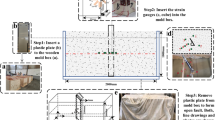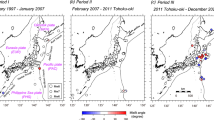Abstract
We used a mechanics conceptual model to provide another perspective to understand the mechanical environment of the San Andreas Fault (SAF), and a possible mechanism that the principal stress state in the SAF is not only affected by remote tectonic stress but also by Poisson’s ratio. For a strike-slip fault like the SAF, we found that in the fault zone with Poisson’s ratio of >0.25, effective friction coefficient and the stress ratio (minimum principal stress/maximum principal stress) are less than 0.1 and 0.8–1.0, respectively, corresponding to remote tectonic stress ratio of 0.36–1.0, and that the higher the Poisson’s ratio, the greater the principal stress rotates. For hydrostatic pore pressure and a received tectonic stress ratio of 0.5 around the SAF, the model predicts that the SAF has a very high Poisson’s ratio (~0.45), which accommodates extremely low effective friction coefficient (0.09) and large stress ratio (0.84) or smaller shear stress (17 MPa).



Similar content being viewed by others
References
Mount VS, Suppe J (1987) State of stress near the San Andreas Fault: implications for wrench tectonics. Geology 15:1143–1146
Zoback MD, Zoback ML, Mount VS et al (1987) New evidence on the state of stress of the San Andreas Fault system. Science 238:1105–1111
Provost AS, Houston H (2001) Orientation of the stress field surrounding the creeping section of the San Andreas Fault: evidence for a narrow mechanically weak fault zone. J Geophys Res 106:11373–11386
Townend J, Zoback MD (2000) How faulting keeps the crust strong. Geology 28:399–402
Zoback MD, Hickman S, Ellsworth W et al (2011) Scientific drilling into the San Andreas Fault zone—An overview of SAFOD’s first five years. Sci Drill 11:14–28
Scholz CH (2000) Evidence for a strong San Andreas Fault. Geology 28:163–166
Byerlee JD (1978) Friction of rocks. Pure Appl Geophys 116:615–626
Rice JR (1992) Fault stress states, pore pressure distributions, and the weakness of the San Andreas Fault. In: Evans B, Wong TF (eds) Fault mechanics and transport properties of rock: a festschrift in Honor of Brace WF. Academic, San Diego, pp 475–503
Hickman S, Zoback MD (2004) Stress orientations and magnitudes in the SAFOD Pilot Hole. Geophys Res Lett 31:L15S12. doi:10.1029/2004GL020043
Tembe S, Lockner D, Wong TF (2009) Constraints on the stress state of the San Andreas Fault with analysis based on core and cuttings from San Andreas Fault Observatory at Depth (SAFOD) drilling phases 1 and 2. J Geophys Res 114:B11401. doi:10.1029/2008JB005883
Lockner DA, Morrow C, Moore D et al (2011) Low strength of deep San Andreas Fault gouge from SAFOD core. Nature 472:82–85
Faulkner DR, Mitchell TM, Healy D et al (2006) Slip on ‘weak’ faults by the rotation of regional stress in the fracture damage zone. Nature 444:922–925
Chéry J, Zoback MD, Hickman S (2004) A mechanical model of the San Andreas Fault and SAFOD pilot hole stress measurements. Geophys Res Lett 31:L15S13. doi:10.1029/2004GL019521
Townend J, Zoback MD (2004) Regional tectonic stress near the San Andreas fault in central and southern California. Geophys Res Lett 31:L15S11. doi:10.1029/2003GL018918
Wang CY (1984) On the constitution of the San Andreas Fault zone in central California. J Geophys Res 89:5858–5866
Boness NL, Zoback MD (2004) Stress-induced seismic velocity anisotropy and physical properties in the SAFOD Pilot Hole in Parkfield, CA. Geophys Res Lett 31:L15S17. doi:10.1029/2003GL019020
Zhao P, Peng Z, Shi Z et al (2009) Variations of the velocity contrast and rupture properties of M6 earthquakes along the Parkfield section of the San Andreas Fault. Geophys J Int 180:765–780
Zhao D, Kanamori H, Negishi H et al (1996) Tomography of the source area of the 1995 Kobe earthquake: evidence for fluids at the hypocenter? Science 274:1891–1894
Zhao D, Ochi F, Hasegawa A et al (2000) Evidence for the location and cause of large crustal earthquakes in Japan. J Geophys Res 105:13579–13594
Salah MK, Zhao D (2003) 3-D seismic structure of Kii Peninsula in southwest Japan: evidence for slab dehydration in the forearc. Tectonophysics 364:191–213
Audet P, Bostock MG, Christensen NI et al (2009) Seismic evidence for overpressured subducted oceanic crust and megathrust fault sealing. Nature 457:76–78
Jaeger JC, Cook NGW (1979) Fundamentals of rock mechanics, 3rd edn. Chapman and Hall, London
Wang X, Schubnel A, Fortin J et al (2012) High V p/V s ratio: saturated cracks or anisotropy effects? Geophys Res Lett 39:L11307. doi:10.1029/2012GL051742
Lachenbruch AH, Sass JH (1992) Heat flow from Cajon Pass, fault strength, and tectonic implications. J Geophys Res 97:4995–5015
Acknowledgments
This work was supported by the National Natural Science Foundation of China (41074070) and Special Research Project in Earthquake Science of China (200808068).
Author information
Authors and Affiliations
Corresponding author
About this article
Cite this article
Xie, Z., Cai, Y. Effects of tectonic stress field and Poisson’s ratio on stress state within the San Andreas Fault zone. Chin. Sci. Bull. 59, 2994–2998 (2014). https://doi.org/10.1007/s11434-014-0216-7
Received:
Accepted:
Published:
Issue Date:
DOI: https://doi.org/10.1007/s11434-014-0216-7




